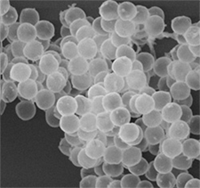Better marker for breast cancer may reduce need for second surgeries
By By Susan Brown | 21 Sep 2010
A new material could help surgeons more accurately locate breast cancers, reduce the need for second surgeries and minimize pre-surgical discomfort for patients. Microscopic gas-filled spheres of silica, a porous glass, can mark the location of early-stage tumors to show their position using ultrasound imaging in the operating room.
A team of chemists, radiologists and surgeons at the University of California, San Diego, created the new material, which they describe in a forthcoming issue of the journal MedChemComm.
 |
| Microscopic glass spheres filled with a gas could make tumors visible with ultrasound during surgery. Credit: Paul Martinez. |
The X-rays used to make mammograms reveal calcium deposits associated with breast cancer even in tumors too small to be felt. But surgeons can't use X-rays while operating. Instead, radiologists place guide wires into tumors hours or even the day before surgery. The wires don't mark depth well and can shift. Patients find them both uncomfortable and unsettling.
As an alternative, the researchers created spheres of silica and filled them with perfluoropentane, a gas that has been used before in short-lived contrast materials for medical imaging. The rigid silica shells help the new material last longer.
''These little gas-filled microbubbles stick to human breast tissue for days and can be seen with ultrasound,'' said William Trogler, professor chemistry. ''If doctors placed them in early stage breast cancer, which is difficult to see during surgery, they could help surgeons remove all of it in the first operation.''
In the past few years, radiologists have tried implanting radioactive ''seeds'' instead of wires to mark tumors, but the seeds last only a few hours and must be inserted with a large-bore needle, which is painful. In addition, only one abnormal region can be marked, but patients with a form of breast cancer called ductal in situ carcinoma often have several. The seeds also expose both patient and staff to radiation, can't been imaged in three dimensions and create radioactive medical waste.




















.jpg)









